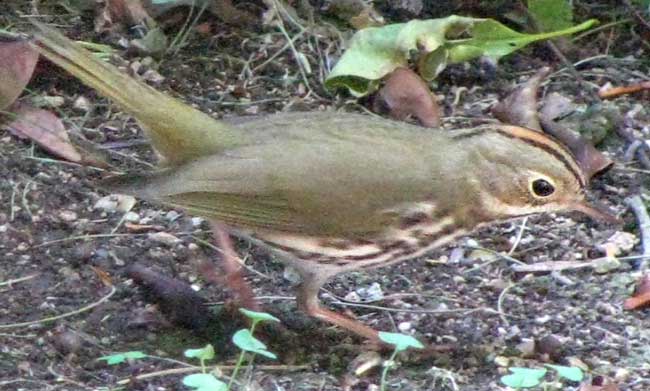Excerpts from Jim Conrad's
Naturalist Newsletter

from the February 20, 2005 Newsletter issued from Hacienda Komchén de Los Pájaros just outside Dzemul, Yucatán, Mexico
OVENBIRDS
I have mentioned how some bird species overwintering here in the Yucatan appear at Komchén for a while, then disappear, as other species come onto the scene for the first time. My guess is that small flocks of various overwintering species are wandering the landscape, and here we are just seeing the flocks as they pass through.
When I arrived in November, Common Yellowthroats and Northern Parulas were common here, but now I seldom see them. In contrast, until fairly recently I never saw Black-throated Greens and Palm Warblers. The Palm Warblers stayed for just a few days, but the Black- throateds are still here.
The most commonly seen warbler at Komchén now is a fairly recent arrival, the Ovenbird, and they're all over the place, walking (not hopping) on the ground, their brown backs, spotted breasts and black stripes on their heads making them easy to identify even in their winter plumage.
Ovenbirds overwinter in southern Florida, the Lesser Antilles, and from central Mexico south to Venezuela. They rear their young in most of eastern North America, though when I was in Mississippi I saw them only during migration, since we lay south of their summer breeding grounds. I've always thought of Ovenbirds as northern forest birds, so seeing them now on our scorched, hot dirt and exposed limestone rock makes them seem out of place. I often look at them and wonder what cool, moist mountain slope or lowland maple forest the individual I'm seeing may have as a nesting ground.
Our Ovenbirds are silent now, but I know that before long birders far to the north will be hearing them singing their loud, clear "tea-cher tea-cher tea-cher" from exposed perches in shadowy forest understory. Maybe I myself will get to hear one of our Komchén birds later this year.
from the April 4, 2010 Newsletter issued from Hacienda Chichen Resort beside Chichén Itzá Ruins, central Yucatán, MÉXICO; limestone bedrock, elevation ~39m (~128ft), ~N20.676°, ~W88.569°
OVENBIRD
Though I hadn't seen a migrant for weeks I had indeed noted changes in the bird population which I suspected to be due to hormone level changes in response to the longer days and shorter nights.
For example, during my banana-buying hike to Pisté I passed a Tropical Mockingbird singing his heart out. Each day Rufous-browed Peppershrikes sing at least awhile, and sometimes the monotonously pulsating calls of so many Ferruginous Pigmy Owls fill the landscape that it's funny. Pairs of Golden-fronted Woodpeckers often engage in chases that are so long-lasting and leisurely that you suspect both parties are enjoying it. It makes sense. When May rains bring forth flowers and insects, nestlings need to be ready for the bonanza.
Because this winter I've seen so few migrants here in the Yucatán's interior I'm guessing that migrants tend to cluster along the coasts. Maybe every two or three weeks I've see a Yellow-throated Warbler and every couple of weeks a Hooded Warbler. About once a month I've see a Black-and-white Warbler or an American Redstart. Once or twice during the whole winter I've seen Northern Waterthrushes and Kentucky Warblers.
And now this week, rushing across the ground in the shadow of a stone wall, I saw the Ovenbird shown at the top of this page.
This bird behaved as if he wasn't familiar with the area, and he let me come closer than normal. I pegged him as an outsider whose hormones had kicked in. Now he's starting to wander a bit, rushing around gorging on all the food he can before soon launching from the Yucatán's northern coast, across the Gulf of Mexico, to the coast of Louisiana, Mississippi, Alabama or maybe Florida. My field guide indicates that the first Ovenbirds arrive on the US Gulf Coast around the first of April, so by the time you read this maybe the bird in the picture already will be resting in a greening Louisiana swamp.
Ovenbirds, SEIURUS AUROCAPILLUS, nest in forested eastern North America, except for the Deep South. They winter from Mexico and the Caribbean to northern South America.